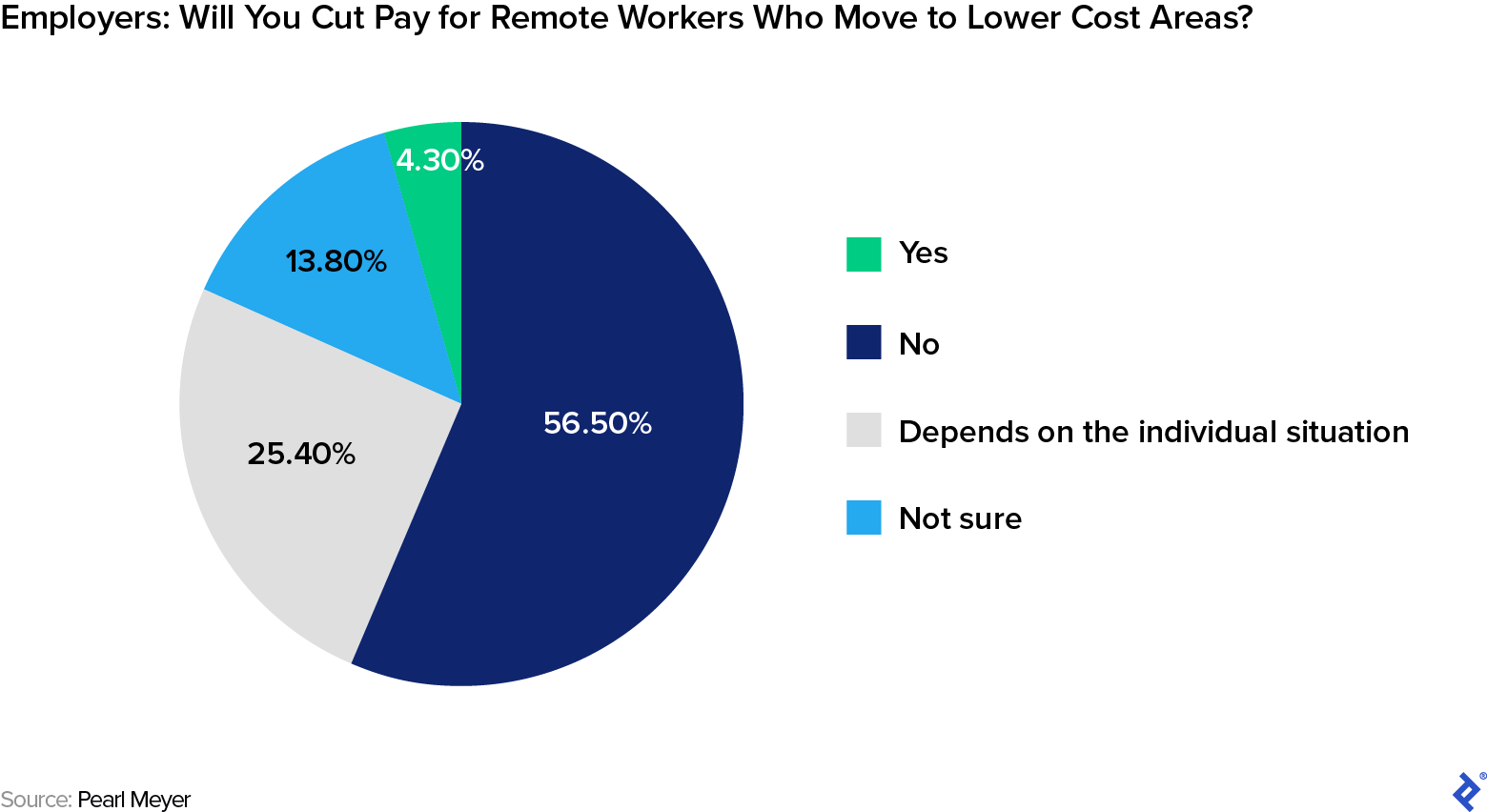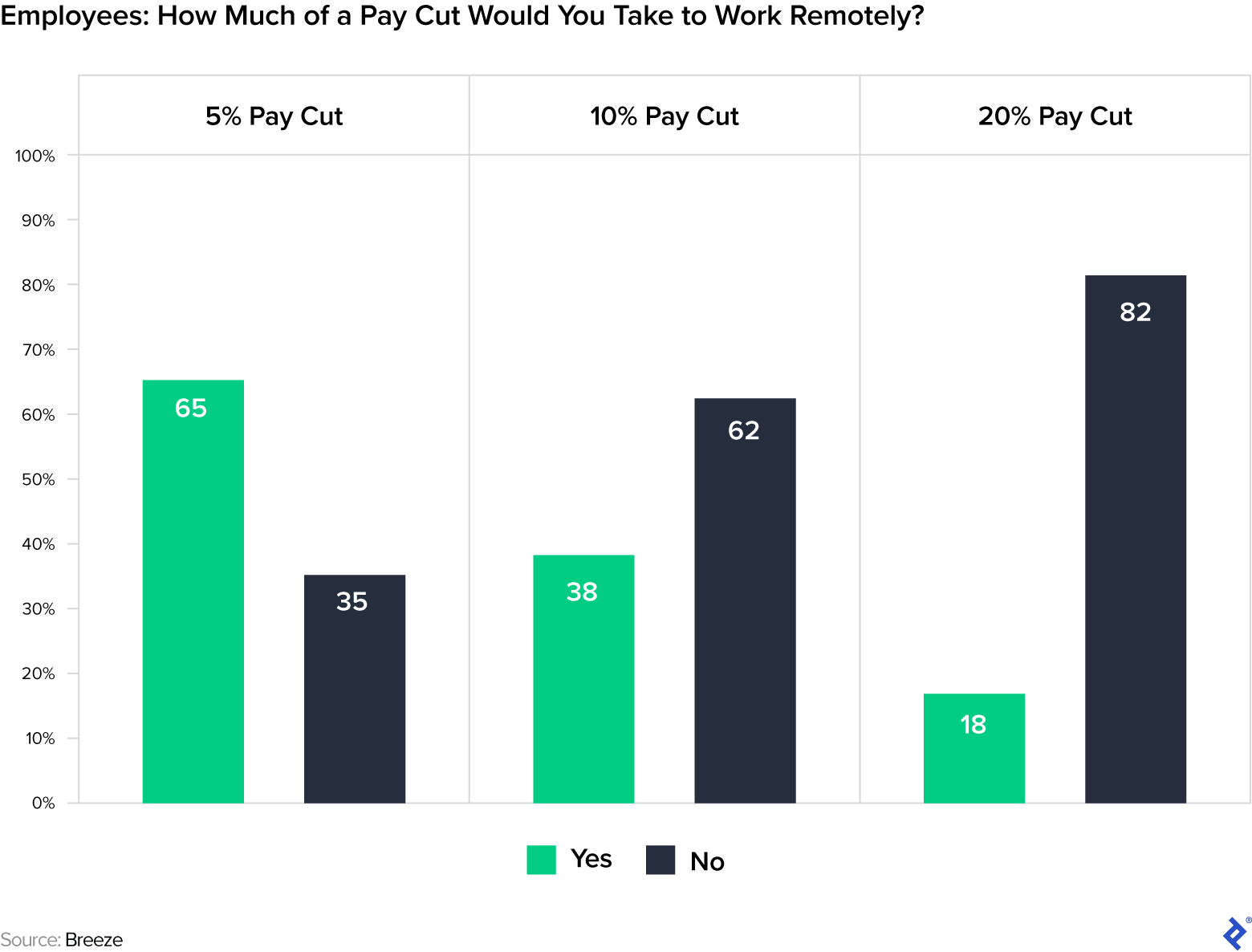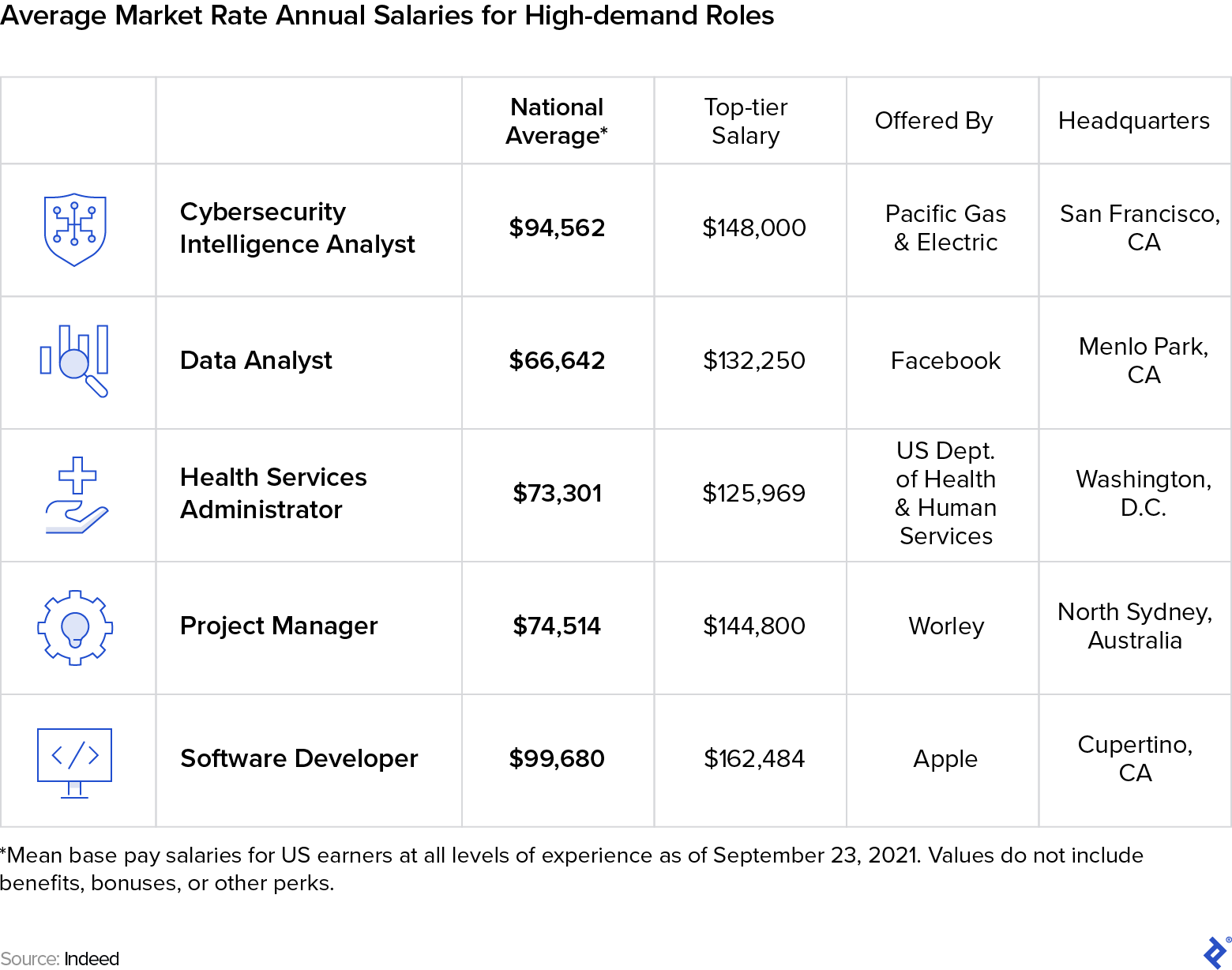Remote Work Compensation: Pros and Cons of 3 Emerging Pay Strategies
authors are vetted experts in their fields and write on topics in which they are extremely knowledgeable. All of our content is peer reviewed and validated by world-class professionals.

The sudden shift to remote work in early 2020 gave employees the freedom to leave high-cost urban centers and move to smaller, often less expensive cities. Almost a quarter of American workers surveyed earlier this year by PwC said they were considering moving more than 50 miles away from their workplaces—and another 12% said they had already moved. Now leaders of newly distributed workforces are grappling with a difficult question: Should they continue to pay the same salaries for workers who move away?
Location has long been a primary factor in developing salary ranges for most nonexecutive jobs, especially for organizations with workers spread across the US or around the globe. The WorldatWork’s 2021 Geographic Pay Policies Study found that approximately 62% of the US companies surveyed have geographic salary differentials that take into account variations in cost of labor and/or cost of living. A majority of workers also expect their pay to reflect their location, the poll found.
But while geographic pay differentials may be expected, what’s new is how remote work is prompting more organizations to make adjustments to their current approach. Nearly one in five employers in a 2021 survey of 349 companies by global executive compensation consulting firm Pearl Meyer said that they’re considering changing their compensation strategies. About 30% of employers in the same survey said they planned to reduce salaries for remote employees who move to lower cost geographic areas, either across the board or on a case-by-case basis. It’s notable, however, that more than half said they wouldn’t—and the rest weren’t sure.

This split isn’t surprising. Businesses are navigating several new challenges, from managing a newly hybrid workforce to recruiting top talent in a volatile labor market. “[Companies] are recognizing there’s value in an employee choosing where they want to be,” says Pearl Meyer Managing Director Bill Dixon. But, “[leaders] are very cautious about making long-term commitments in a moment where there’s so much uncertainty.”
The corporate decisions about compensation for remote employees will affect future revenues, branding, and the ability to compete in the talent economy for years to come. Considering this unprecedented moment, Staffing.com has dug deeper into how companies set salaries for remote jobs, identifying today’s three most common hybrid compensation policies. Top business thought leaders have come forward to discuss the pros, cons, and best practices.
Three Emerging Remote Work Compensation Models
The Big Tech Model
Facebook, Google, and Slack all used geographic salary structure differentials before the COVID-19 pandemic—and all three companies have recently adjusted them to address the shift to remote work. CEO Mark Zuckerberg announced in a Facebook Live video that employees working remotely must notify the company if they move to a new area so the company could adjust salaries accordingly. Google launched a tool allowing employees to see how much their salaries would change if they relocated. Slack expanded its salary range from two location-based pay tiers to five.
“A tech company like Google is located in a very high cost-of-living area where wages are significantly higher than national norms,” says Dixon. “Those companies are saying, ‘We don’t need to pay you at a San Francisco wage if you’re living in Montana.’”
VMware, a major cloud computing software provider and subsidiary of the Fortune 100 technology company Dell, is also adopting this big-tech model of remote pay. Employees who move from the company’s headquarters in Palo Alto, California, to Denver, for example, will receive a pay cut of 18%, while a move to Los Angeles or San Diego would equal a 5% drop, according to Bloomberg. (At Google, working from home two hours away from the company’s Seattle office would result in a 10% salary dip, one employee told Reuters.)
Reducing salaries can offer significant cost savings, and many workers are prepared to earn a little bit less in return for the continued flexibility of remote work. A majority of respondents in a recent survey by disability and illness insurance company Breeze said they would accept a 5% pay cut if it meant they could work from home indefinitely—the opposite was true for cuts of 10% or above.

But experts warn that some companies are much better positioned to reduce pay of current employees than others. “Many of these tech companies use equity or long-term incentives, and they’re not changing that,” Dixon says of the lucrative financial carrots offered by businesses like Google. For companies that don’t offer the same benefits and prestige, salary cutting can be more perilous.
“The risks are similar to any situation where employers take actions that are seen as manifestly unfair: quitting and resentment that leads to reduced performance,” says Peter Cappelli, Professor of Management and Director of the Center for Human Resources at The Wharton School of the University of Pennsylvania.
Those risks are especially concerning right now in light of the so-called “Great Resignation.” A record number of American workers—15 million between April and September 2021—have quit their jobs, many saying they felt undervalued by their companies or managers or citing poor work-life balance. “Top talent has a lot of choices right now,” Dixon says. Those high-performing workers you really don’t want to lose are the very ones who have the most choices in the current marketplace, he notes.
Transparency is the key to a successful rollout of location-based pay, our experts say. “As part of our shift to a distributed workforce model, we are providing transparent information to employees to help them make informed and educated choices about their preferred work location for their individual circumstances,” Michael Thacker, Director, Corporate Public Relations at VMware, tells Staffing.com. A tent pole in that strategy is an internal salary tool—much like the one Google launched in June 2021—that employees can use to see how their compensation will potentially change if they relocate.
The Headquarters Model
Another emerging option for remote work compensation is to pay employees based on the going rate wherever the company calls home. That’s what Reddit is doing for its US workers, most of whom can now choose to work from home permanently or part time. “To support employees to live where they want to and do their best work, we are eliminating geographic compensation zones in the US,” the company announced in a 2020 blog post. “It means that our US compensation will be tied to pay ranges of high-cost areas such as San Francisco and New York, regardless of where employees live.”
Real-estate company Zillow is also keeping remote work compensation stable, whether they move away from the company’s Seattle headquarters or not. “If a Zillow employee chooses to relocate in 2021, we are not changing that employee’s pay based on where they move,” Meghan Reibstein, Vice President of Organizational Operations, tells Staffing.com. “We are working to evolve our compensation approach to support distributed work in the long term, with a focus on an employee’s role and performance rather than on geography. Our goal is to enable flexibility, maintain pay equity, and attract and retain top talent.”
This approach will likely give Reddit, Zillow, and other companies who adopt it an edge in the fight for in-demand talent, particularly in roles like IT, software development, and healthcare, where there is an especially heavy shortage of candidates.

The National Market Rate Model
A growing number of companies are moving toward a national market rate mostly based on the “value” of the skills someone brings to the table, rather than their location. Tauseef Rahman, Partner at Mercer, a consulting and risk management company and subsidiary of the Fortune 500 global professional services company Marsh McLennan, recommends this strategy—especially for jobs that are extremely competitive or hard to fill. “If it is an in-demand job or skill set with limited supply, then the labor market may tend to be more national,” he says. Offering a market rate also helps smaller companies or those located outside of major urban hubs to compete for top talent.
It levels the playing field even more if these companies are willing to boost their usual compensation for remote workers who live in expensive areas. “If you are recognizing the geographical differentials in places like Seattle, New York City, and the Bay Area and paying a premium for folks who need to be located in those cities, of course that will help you find talent,” says Dan Healey, Vice President and Head of Human Resources, North America, at SAP.
That’s the software giant’s approach. Its US headquarters are based in Newtown Square, Pennsylvania, with more than a dozen branches across the country. “We know the war for talent is huge—especially in the technology sector, so being competitive is important,” says Healey. “We have a national compensation structure for every position we have at SAP, which is multi-tiered—based on experience, level in the organization, and more—and we do have a geographical premium for employees who live in high-cost areas.”
Choosing the right approach for your business isn’t just about dollars and cents. Business leaders must evaluate their priorities when considering a remote or hybrid compensation policy, moving forward with transparency, and crafting strategic communications for strong internal and external messaging. Companies that ultimately decide to reduce pay for remote employees who move away should also prep their HR specialists and invest in a robust talent acquisition team to prepare for possible blowback and attrition.
